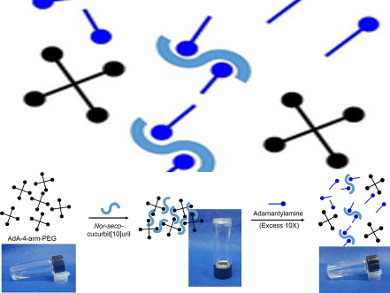Self-assembled soft materials such as supramolecular hydrogels have shown great promise in biomedical applications such as tissue engineering, cell therapy, and drug delivery. Their soft nature makes them biocompatible; however, it also means that they are not robust enough for most practical applications.
Kimoon Kim and colleagues, Institute for Basic Science and Pohang University of Science and Technology (POSTECH), South Korea, have prepared a supramolecular hydrogel which is able to ‘self-heal’ after it is damaged. The hydrogel is made by mixing two simple starting materials, which were both synthesized by one-step reactions from commercially available compounds (pictured): Guest (adamantylamine)-anchored hydrophilic polymers were stitched together using a host molecule (nor-seco-cucurbit[10]uril) that acts as a supramolecular crosslinker by accommodating two guest molecules in its cavity.
Because of the dynamic and reversible nature of the host–guest interaction, the hydrogel recovers its mechanical properties to near those of the pristine material, even after multiple damage–healing cycles, therefore, showing potential as a promising biomaterial with a prolonged lifetime.
- Self-Healable Supramolecular Hydrogel Formed by Nor-Seco-Cucurbit[10]uril as a Supramolecular Crosslinker,
Kyeng Min Park, Joon Ho Roh, Gihyun Sung, James Murray, Kimoon Kim,
Chem. Asian J. 2017.
DOI: 10.1002/asia.201700386
